The short, strange life of the “other” E-Class—the Chrysler kind
Surely you’ve heard of the E-Class? That Stuttgart stalwart providing the very finest in Teutonic midsize luxury motoring for 70 years now? Yes? Well, there was another E-Class, one that came from Detroit’s Jefferson Avenue. This is the Chrysler E-Class, an early supporting player in the ever-expanding cast of K-car spinoffs that helped rescue Chrysler Corporation in the early 1980s.
Hindsight, and Ford’s famously cheesy ersatz-Mercedes marketing for its 1970s Granada, might suggest that this “other” E-Class was a similar Benz wannabe, but it wasn’t. Stuttgart only relabeled the W124-series as the E-Class in 1993, and nobody really called the W123-series cars “E-Classes” back then. Instead, Chrysler’s label comes from the car’s “E-body” platform, shared with the Dodge 600 sedan and downsized Chrysler New Yorker, introduced in the fall of 1982.

By the time they were in showrooms, Chrysler was headed for recovery, and chairman Lee Iacocca was hailed as “Detroit’s Comeback Kid” thanks to the K-cars’ success. The E-bodies, the first stretched K variations, proved fairly popular, and more than 700,000 of them were sold through 1988. But the E-Class? It landed with a thud and lasted only through 1984.
What did not resonate then, however, generates lots of curiosity today, says owner Ben Reidell, often from people too young to recall the 1980s. “When I’m at a restaurant in a trendy part of town I’ll often see 20-something hipsters staring at it or taking pictures with it,” Reidell says. “There are still people who say the usual nasty things about K-cars at shows,” he adds, “but there’s much more interest in these cars now than a decade ago.”
This is true of all of the early K-cars in the era of Malaise Motors and Radwood, but the E-Class is an oddity even among 1980s Mopar fans. Its creation is the story of how Chrysler Corporation became so dependent on the K-car architecture, but its demise was a classic Chrysler marketing tale. The car was essentially a Lee Iacocca-era DeSoto.
The Cash Crunch and the K-Car

Although Iacocca and his engineering right-hand Hal Sperlich often get the credit for the K-cars, they had already been in development during the John Riccardo era and can trace their origins to former subsidiary Simca. The K-car didn’t reuse much from Simca/Chrysler Europe designs but, post-OPEC, the efficiency and popularity of those foreign designs convinced Chrysler that the huge investment in new front-drive architecture was worth it.
But while the K-car was always meant to replace the troubled F-body Dodge Aspen/Plymouth Volaré, former Body Engineering director Burton Bouwkamp said in 2009 (and on many other occasions) that the stretched E-bodies weren’t part of the original program. They were created out of necessity and their origin dates to mid-1979, when Chrysler’s rear-drivers were in sales free-fall and the company was selling off assets to keep the lights on.
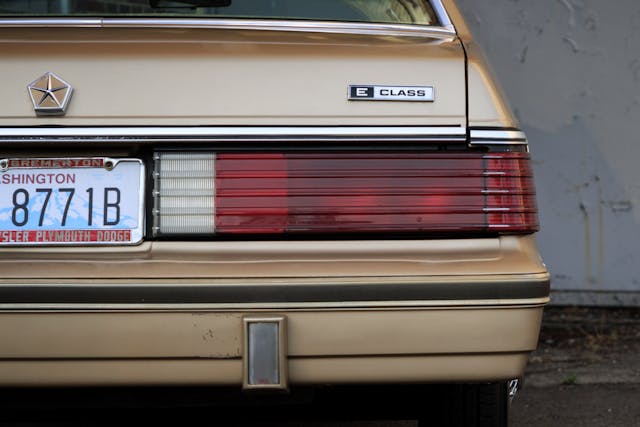
Chrysler’s only good sellers then were the L-body Dodge Omni/Plymouth Horizon, cousins to the European Chrysler Horizon. At a long-term planning meeting in Boca Raton, Florida, that year, the brass decided that, except for the image-building Imperial, the Corporation’s rear-drive cars and light trucks weren’t worth investing in. Instead, Iacocca put all of Chrysler’s chips on the K-car and, at Riccardo’s urging, began shoring up political support for government loan guarantees.
Iacocca had already been seeking outside investors, including Volkswagen, John DeLorean, and even Saudi arms dealer Adnan Khashoggi, but none of those potential rescuers panned out. In February 1980, Chrysler posted the largest loss in U.S. corporate history up to that time: $1.71B. In May, the loans were approved. With them came drastic cuts to labor and wages, and the Corporation would continue to burn cash into late 1981.
It was in this crucible that the first K-car spinoffs were born. In Iacocca’s view, the Corporation “had to remain a full-line manufacturer. We couldn’t survive on just the K-cars.” First came the 1982 Chrysler LeBaron and Dodge 400, with longer overhangs and frillier styling, but basically fancy Ks. The E-cars would be the first larger versions.
The Rise and Fall of the Chrysler E-Class

Creating these cars couldn’t have been any cheaper. Ahead of the B-pillar, the E-Class was essentially identical to a LeBaron. The wheelbase was stretched three inches and rear overhang increased by 2.5 inches, yielding 2.1 cubic feet more trunk space than its little brother. It also used the same engines as the LeBaron—Chrysler’s 2.2-liter and Mitsubishi’s 2.6-liter fours—and all of the smaller car’s mechanical pieces. Was it exciting to drive? No, but it was roomy, comfortable, and capable of returning 24 mpg combined.
The New Yorker, introduced several months after the E-Class and 600 sedan, got more differentiation, but it was also done on the cheap, by adding chrome, fancier interior bits, and a more formal roofline, which was really just a simple plastic roof extension disguised by a big vinyl top. There was undoubtedly confusion at Chrysler stores as the New Yorker name was now split between the downsized E-car and the old, rear-drive M-body New Yorker Fifth Avenue, itself formerly the 1981 LeBaron.

Although Mercedes was not their inspiration, the E-Class and 600 names self-consciously affected an “import fighter” accent. To differentiate them from their smaller siblings, Highland Park’s product planners attempted to cast them as “European-style touring sedans,” phrasing used by execs and reviewers alike when the cars were new. These names, they hoped, might also link them in buyers’ minds to imports like Audi, Saab and Volvo.

Dodge, always a sportier brand, leaned especially hard into this idea, and in 1983 and 1984 its top trim was the “ES,” for “Euro/Sport.” It came with a beefed-up suspension, blackout trim, a standard five-speed, and the tagline “America’s Driving Machine.” Were consumers fooled? Not really, but the 600 ES and New Yorker were distinctive. The E-Class wasn’t.
Although the car and the name were new, the concept was familiar. It filled the same niche as the old Newport (dropped in 1981), a decontented New Yorker for the no man’s land between Plymouth and Chrysler. Early on it sold well, but the New Yorker soon stole the limelight and Chrysler barely marketed the E-Class beyond a few print ads and a TV spot with Ricardo Montalbán. Notably, that spot had a New Yorker and an Executive Limo in the background, all generically referred to as “E-Classes.”

In 1984, despite power bumps for the 2.2 and 2.6, and the addition of the potent 140-horsepower turbocharged 2.2, the New Yorker outsold the E-Class 2:1. By then, Chrysler’s cash crunch had abated and the string of low-cost K-car spinoffs were making bank, allowing more differentiation for each successive spinoff. For 1985, the “aero look” H-body Chrysler LeBaron GTS and Dodge Lancer hatchbacks would arrive, instantly dating the boxy E-cars.
Thus, at the end of 1984, the E-Class quietly morphed into the Plymouth Caravelle, a name previously used in Canada. The styling grew smoother, but it was essentially the same car from the same dealer with a $600 price cut and less luxury pretense. It immediately outsold the E-Class and lasted into 1988. Of course, Chrysler became addicted to the low-cost/high-profit situation with the Ks, and the big cuts of 1980–81 meant it was starved for new ideas and talent until around the time of the AMC acquisition in 1987.
The K-Car Collector
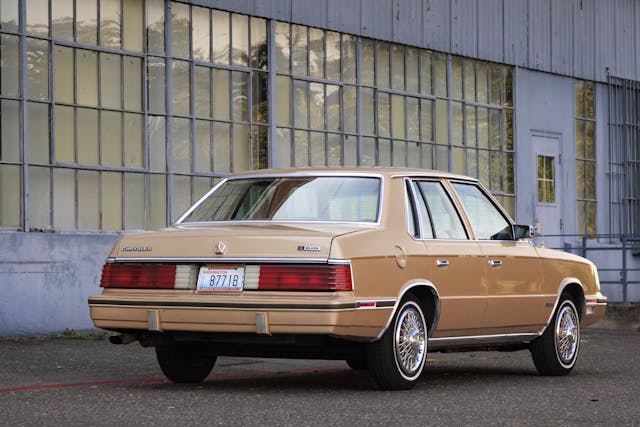
A dud back then, the E-Class has more appeal now thanks to a rising K-car tide. Funnily enough, owner Reidell says, “K-cars often appeal to the same people who like Audis, Saabs, and Volvos, because they’re quirky and unusual but accessible.”
A lifetime fan whose uncle bought a 1982 LeBaron new and whose collection also features five other Ks, including a 1990 Chrysler Town & Country, Reidell was drawn to his ’84 E-Class for its rarity and clean looks. “They made them for two years and there’s less gingerbread on them than LeBarons or New Yorkers.” Liking such cars, however, hasn’t always been easy.
For years, K-cars and their fancier spinoffs were derided as basic and cheap by most enthusiasts, a perception not helped by Chrysler’s over-reliance on its golden goose platform. This attitude began to change about 15 years ago, Reidell says. “At first it was just a small group of people interested in them, but lots of people have K-car memories.”
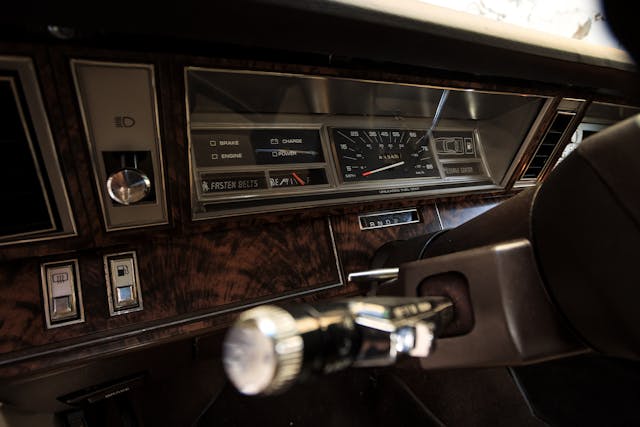
Over time, with phenomena like Radwood, Malaise Motors, and Concours d’Lemons, they’ve become even more popular. “These events really brought out a lot of people who maybe had a tangential interest in unloved ’70s and ’80s cars but had never had one. It feels like the K-cars are finally getting respect.”
They’re also not as unsophisticated as they’re sometimes made out to be. On paper, Reidell’s ’84 Turbo looks more like an actual European car than any of its domestic competitors. A front driver with a turbocharged overhead cam four weighing 2600 pounds? With MacPherson struts up front and trailing arms at the rear? Chrysler designed the cars to withstand lots of abuse and neglect, which is one reason why they aren’t as light and lithe as similar Europeans, but they work.

The turbo also does wonders for its performance, and it’s much quicker than some of his other non-turbo Ks. “You feel like you can keep up with modern traffic.” The E-Class is not as capable a handler as 1980s-era Volvos and Volkswagens, Reidell says, but it’s also easier to work on and get parts for, which is not something anybody will ever say about a Mercedes E-Class. “These cars are simple and honest by comparison,” he adds.
It also has Chrysler’s famous “Electronic Voice Alert” system, which was annoying to new owners then but a great party trick today. “If you’re into nerdy, unusual cars,” Reidell says, “they’re a great way to inexpensively get into having an old car.”
***
Check out the Hagerty Media homepage so you don’t miss a single story, or better yet, bookmark it. To get our best stories delivered right to your inbox, subscribe to our newsletters.
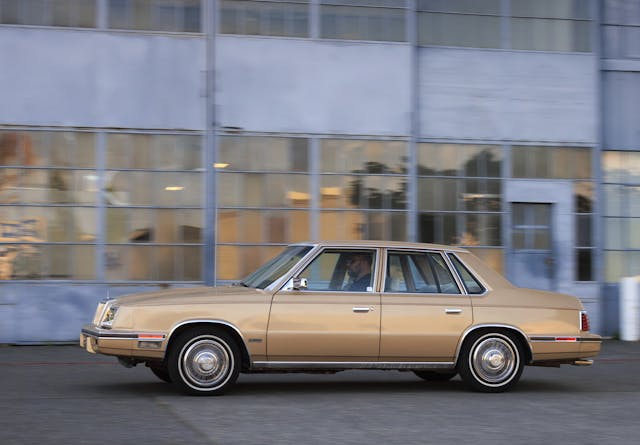
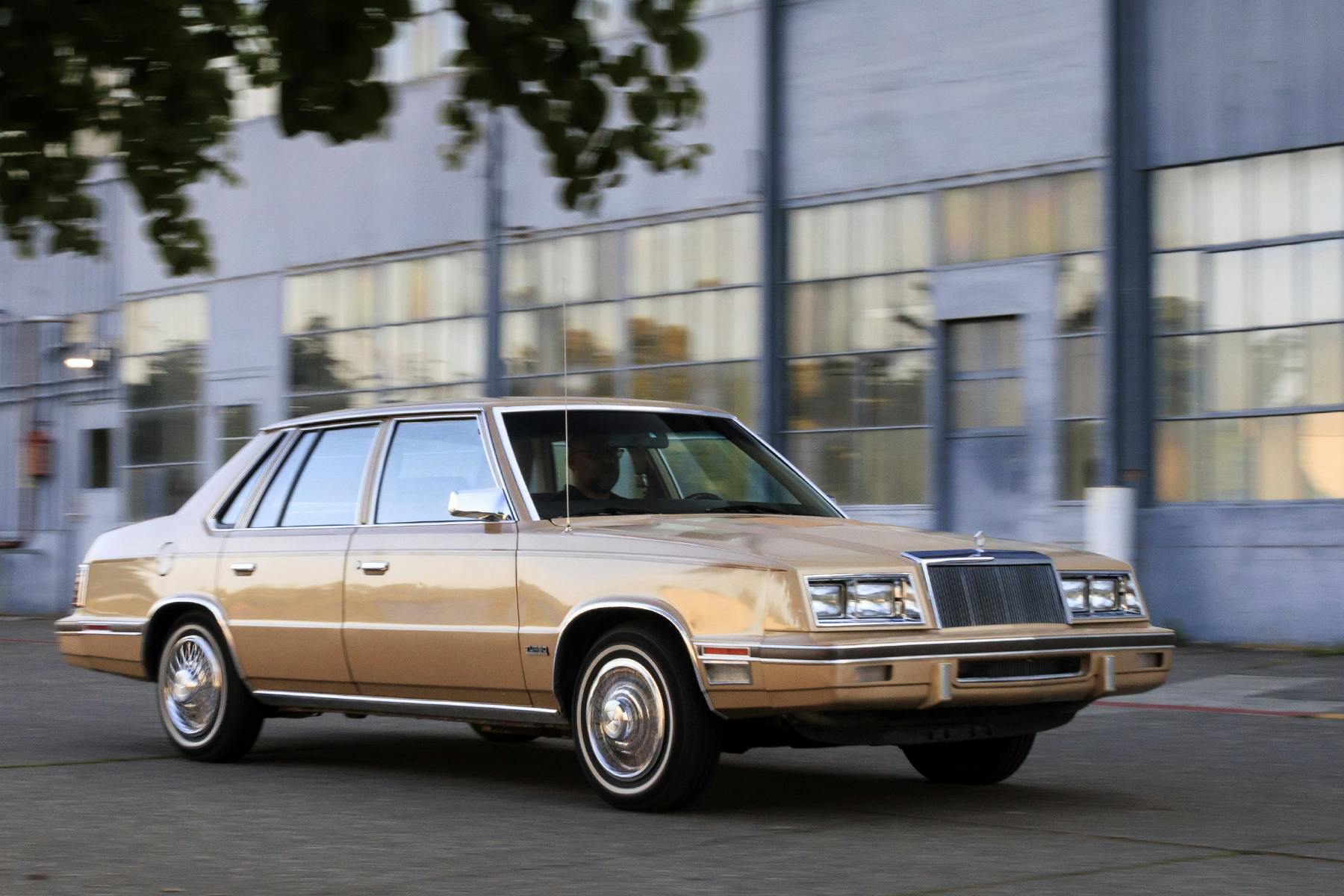
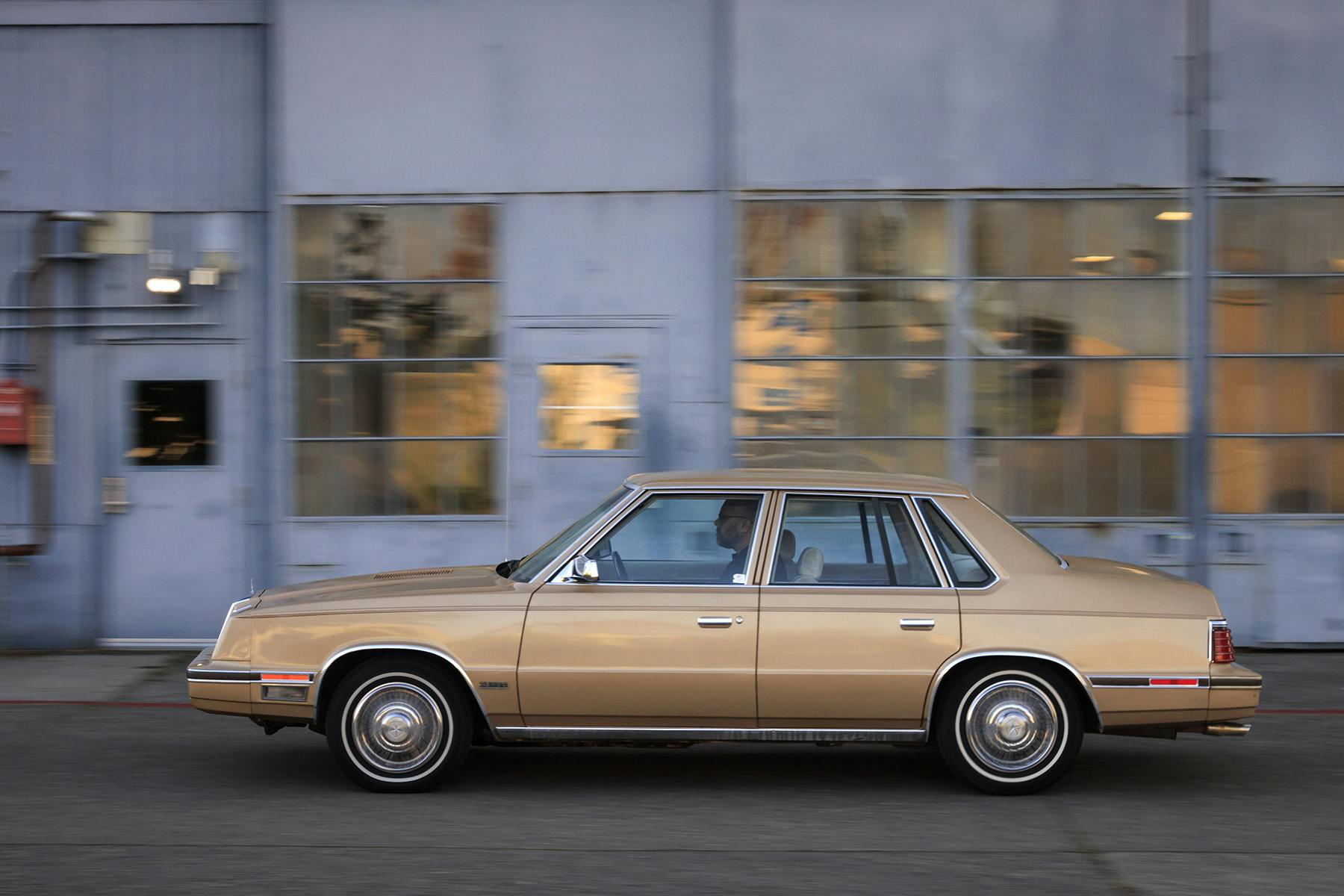


Good article, and great photography.
You’ve actually made these cars interesting!
I am the founder of and president of the Chrysler K-Car Club, and I had a major role in saving these classic Chrysler K-Cars. I have a collection of my own. The last 83 E-Class in California is rotting at an auto shop in Pasadena, CA and has the 2.6 engine and talking EVA. I have the last 82 TC Wagon 2.6 in California. Very glad to see you saved the last turbo E-Class in perhaps most of the United States. We did have a club member crush the last 1984 Dodge 600 ES Turbo Sedan in existence because he was angry he was not getting $30,000 for it. That car was as pristine as your E-Class. We also have a member in California who saved the last 1983 Dodge 600 in existence on the West Coast.
You know you’ve really jumped the shark when you are willing to destroy a perfectly good car out of spite. They won’t ever be (in my lifetime at least) a $30K car but they’ll be appreciated. This is coming from an owner of an 81 Imperial EFI which is unusual in and of itself. I once owned a 1987 New Yorker Turbo. It was merely an older used car then I saved it from certain death for $800. Enjoyed it and learned a lot about the turbo system many of these cars had.
“We did have a club member crush the last 1984 Dodge 600 ES Turbo Sedan in existence because he was angry he was not getting $30,000 for it.” He sure showed THEM!
Had a new company supplied 86 Lebaron GTS Turbo for a time. It was a hot ride for the day! Nicely styled inside and out. Next company (and car) was an iron duke Century. Ugh. Vibrating steering wheel at idle.
I had a silver E-Class as a company car when I was a sales rep for HP in the early 80’s. One day I came out into the parking lot to discover the car was having a nervous breakdown. The electronic voice alert system was running through every combination of warnings (headlights on, fuel is low, fasten seat belt, etc. etc.- The best one being the answer to the old question, ‘When is a door not a door?’ When it’s ajar! Your door is ajar!
These cars never did much of anything for me. The Turbo motors were interesting but not exciting.
I had two Plymouth Caravelle company cars back when they were new. As the article says, they were roomy and comfortable. Much better than the equivalent Celebrities and Tempos in the fleet. The dealership gave me a K-car for a loaner for a time, and I was amazed at the difference between the two, knowing that one was just another version of the other.
My father bought a new Plymouth Caravelle in 1985, dark red with red interior. It was the standard EFI 2.2 liter, and it was actually quite nice. The only negative part was the trunk lid that did not open far enough, making it a head knocker.
I had an E class but the Mercedes version, a ‘92 w124 400E. Comparing the two is kind of laughable. Mine topped 230,000 mikes without even any engine or transmission work. A fast V-8 that handled amazingly well. The K cars were interesting but not my bag.
Comparing the sales price and maintenance costs is laughable as well.
I started working at a Chrysler/ Plymouth dealership in early 1984. I remember the K cars as being easy to work on since every model was basically the same. Early head gasket issues and worn camshaft lobes aside, the engines were simple to maintain. They improved, slightly, with the 2.5l. Who remembers the 2.2l manual transmission Voyager?
Me, we had a customer at our dealership that bought one new than had us change the differential ratio. For its era it was very fast and hilarious to watch people as they were smoked from stop lights.
I remember being told the worn camshafts were the result of using too large an oil filter. Supposedly the big filter (same threads and gasket diameter as the small one spec’d for the 2.2; typically used on Mopar V8s and Slant Sixes) took too long to fill and the cam ran dry for the first few seconds on a cold start. I would think the check valve would prevent that but who knows. My 82, using the big filter, chewed up a cam but with the small filter the cams on my 86, 87, and 90 2.2s remained intact over 100K.
I drove a first-year Caravan, 2.2/five speed, and found it entertaining. There was lots of shifting involved as the 2.2 struggled to deal with the extra weight of the van, but it was capable of keeping up with traffic on surface streets and freeways.
Most interesting was the front seat configuration: a split 60/40 bench, making it (theoretically) an eight -passenger conveyance. The 2.2 would definitely have struggled with that load.
A customer had a New Yorker Turbo. He also had a lead foot. The extra power and constant hard acceleration blew out the differential. I thought it was a one-off problem but a few years later the same thing happened to a coworker whose Caravan had the same drivetrain. I’m guessing the engine was beefed up but the differential wasn’t.
I’m glad to see mention of the Chrysler Newport. Stellantis needs to revive that nameplate for its first EV. Calling it a Newport seems perfect: a nod to tradition and a wink at the new method of refueling.
I am all for that! Drove a 71 Newport for many years. A long, low, stretched out 2-door with the 10 foot rear fenders(that’s a joke). It was a giant car, and I used to tell people that you could sleep in the trunk if you had to! No one doubted me. Olive green with Sunspoke rims and Dunlop white letter tires. Beautiful! All I have now is a photo album full of Polaroids and 110’s of my beauty.
I had an 81 Reliant wagon, 2.2 L4 with 4 speed on the floor. Nice ride but not sporty. Lots of room inside but the shifter reminded me of a friends 65 Corvair Monza turbo with a shift linkage that was like rowing a boat until you found a slot. Over 120000 miles with nary an issue. My parents also had an 81 Reliant sedan which seemed a little m ore upscale than my wagon. Again, it did just over 100k without any issues.
I was selling cars back in the ’80’s and remember an older customer, who did not like wearing a seat belt, test drive an ’84 Chrysler New Yorker with the voice alert. After numerous prompts to “fasten your seat belt” she complied. When the voice alert thanked her for buckling up, she commented “he is courteous as well as patient”!
Maybe no car was more UNderservedly panned than the Ks. (Ok maybe the Horizon) They did what they were designed to do and did it pretty well. I had a Spirit that was more than competent. And a 600 which was really nice.
For the era, Chrysler did pretty well.
Bought a 82 Reliant 2.2 LE 4 dr sedan brand new. Towed a 1000 lb Starcraft popup camper with 2 12 year old boys to southern calif from Wis and back. put over 100k on it and never let me down. Bought a 86 Lancer 2.2 fuel injection with similiar results. Just bought a very nice 83 Aries 2.5 as my fun car and every time I drive it there is a smile on my face!
I inherited my mom’s 1984 Reliant 2.2 in 1992 (24,000 miles) when she died. I drove it until 2016 (198,500 miles) when I retired and no longer needed it plus it wouldn’t pass inspection due to rust in the floor. Wasn’t impressed at first but I grew to love that car, affectionately dubbed “the Runt” by my kids. The only major work done was replacing the 3-speed automatic with one from a 1987 Chrysler turbo. What a difference that made in the acceleration! Like a completely different car. Great car in the snow, too. The new owner was going to fix the floor and use it for work. I asked him to keep in touch but, of course, he didn’t. Hope she got a good home and is still going strong.
I really enjoy this article and have read it several times because of that. My parents bought a brand new 83 EClass with the two tone chocolate brown over gold metallic. Nice looking car. Ours was sparsely equipped since dad hadn’t yet gotten over his “practical” side of car buying lol (“why does anyone actually NEED power windows?”…he would say). It also only had the base little 2.2 and automatic, but still an entertaining ride. Little known fact – these were initially going to be named Gran LeBaron! In fact when dad and I took a test drive of one of the first to arrive at our local dealership, the key tag for it said Gran LeBaron!! Plymouth was all too accustomed to adding Gran/Grand to the model names in the 70s and 80s to signify “larger” and “fancier” lol!!